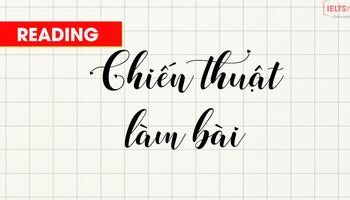Matching Paragraph Headings - nối tiêu đề đoạn văn là dạng bài tập xuất hiện trong bài thi IELTS reading hay làm khó nhiều thí sinh. Bài viết sẽ chia sẻ cho cac bạn bí quyết luyện tập nối tiêu đề với các đoạn văn một cách hiệu quả nhé!
Một loại câu hỏi phổ biến trong IELTS Reading sẽ yêu cầu bạn lựa chọn tiêu đề của các đoạn văn và nối chúng với các đoạn văn trong văn bản bạn sẽ được luyện tập một cách thành thạo hơn!
Các chiến lược để trả lời câu hỏi
- Nhanh chóng đọc qua các tiêu đề để biết chúng nói về cái gì.
- Sau đó nhìn vào đoạn đầu tiên.
- Thường thì chỉ cần đọc câu chủ đề một cách cẩn thận vì ý tưởng chính và câu trả lời là ở đó - bạn có thể skimming (đọc lướt ý chính) qua phần còn lại.
- Tuy nhiên, đôi khi câu trả lời không có trong câu chủ đề và bạn phải đọc toàn bộ đoạn văn 1 cách cẩn thận hơn.
- Nếu chưa chọn được đáp án phù hợp, chuyển sang câu tiếp theo.
- Nếu như lúc đầu bạn vẫn phân vân giữa hai câu trả lời, hãy chọn cả 2. Sau đó bạn có thể loại 1 trong 2 sau nếu nó phù hợp với một đoạn văn khác hơn.
- Nếu cuối cùng bạn vẫn bị mắc kẹt giữa hai câu trả lời cho một câu hỏi, chọn 1 cái phù hợp nhất.
Những điều cần lưu ý:
- Luôn luôn có nhiều lựa chọn trong phần tiêu đề hơn so với số lượng đoạn văn thực sự, vì vậy hãy cẩn thận khi nối chúng.
- Cẩn thận với các từ đồng nghĩa - thông thường, từ ngữ trong đoạn văn và các tiêu đề của đoạn văn sẽ không giống nhau; chúng sẽ là các từ đồng nghĩa.
- Có một danh từ giống nhau trên tiêu đề và đoạn văn không có nghĩa đây đã là đáp án đúng - bạn vẫn cần phải đọc lại cẩn thận để kiểm tra.
Một đoạn văn thực hành:
Trước khi bạn làm 1 bài đọc đầy đủ, chúng ta sẽ cùng nhau thực hành với một đoạn văn ngắn trước. Đây là đoạn văn đầu tiên từ bài đọc đầy đủ mà bạn sẽ làm. Chỉ có năm tiêu đề để lựa chọn cho đoạn đầu tiên này (ít hơn so với đọc đầy đủ).
Hãy làm theo các bước ở trên, và nhấp vào câu bạn nghĩ là câu trả lời đúng. Câu chủ đề có màu đỏ để nhắc nhở bạn tập trung vào nó.
| Yoruba Towns A. The Yoruba people of Nigeria classify their towns in two ways. Permanent towns with their own governments are called “ilu”, whereas temporary settlements, set up to support work in the country are “aba”. Although ilu tend to be larger than aba, the distinction is not one of size, some aba are large, while declining ilu can be small, but of purpose. There is no “typical” Yoruba town, but some features are common to most towns. |
1. Match the correct heading to the paragraph.
Town facilities
Colonisation
Urban divisions
Architectural home styles
Types of settlements
Bây giờ bạn đã biết một số chiến lược và đã luyện tập với một đoạn văn, bây giờ bạn có thể thực hành nối các tiêu đề với đoạn văn trong một văn bản đầy đủ.
Matching Paragraph Headings - Practice
Read and focus on the topic sentences in the text below and then match the paragraph headings to their paragraphs.
One has been done for you.
[Please note that if you are on a mobile device, you have to go to 'navigation' or scroll down to the bottom of the screen to see the questions]
The reading passage has seven paragraphs: A – G.
Choose the most suitable paragraph headings B – G from the list of headings on the right.
Write the appropriate numbers (i –ix) in the text boxes below the headings.
NB There are more paragraph headings than paragraphs so you will not use them all.
| Yoruba Town A. The Yoruba people of Nigeria classify their towns in two ways. Permanent towns with their own governments are called “ilu”, whereas temporary settlements, set up to support work in the country are “aba”. Although ilu tend to be larger than aba, the distinction is not one of size, some aba are large, while declining ilu can be small, but of purpose. There is no “typical” Yoruba town, but some features are common to most towns. B. In the 19th century most towns were heavily fortified and the foundations of these walls are sometimes visible. Collecting tolls to enter and exit through the walls was a major source of revenue for the old town rulers, as were market fees. The markets were generally located centrally and in small towns, while in large towns there were permanent stands made of corrugated iron or concrete. The market was usually next to the local ruler’s palace. C. The palaces were often very large. In the 1930’s, the area of Oyo’s palace covered 17 acres, and consisted of a series of courtyards surrounded by private and public rooms. After colonisation, many of the palaces were completely or partially demolished. Often the rulers built two storey houses for themselves using some of the palace grounds for government buildings. D. The town is divided into different sections. In some towns these are regular, extending out from the center of the town like spokes on a wheel, while in others, where space is limited, they are more random. The different areas are further divided into compounds called “ile”. These vary in size considerably from single dwellings to up to thirty houses. They tend to be larger in the North. Large areas are devoted to government administrative buildings. Newer developments such as industrial or commercial areas or apartment housing for civil servants tends to be build on the edge of the town. E. Houses are rectangular and either have a courtyard in the center or the rooms come off a central corridor. Most social life occurs in the courtyard. They are usually built of hardened mud and have roofs of corrugated iron or, in the countryside, thatch. Buildings of this material are easy to alter, either by knocking down rooms or adding new ones. And can be improved by coating the walls with cement. Richer people often build their houses of concrete blocks and, if they can afford to, build two storey houses. Within compounds there can be quite a mixture of building types. Younger well-educated people may have well furnished houses while their older relatives live in mud walled buildings and sleep on mats on the floor. F. The builder or the most senior man gets a room either near the entrance or, in a two storied house, next to the balcony. He usually has more than one room. Junior men get a room each and there are separate rooms for teenage boys and girls to sleep in. Younger children sleep with their mothers. Any empty room are used as storage, let out or, if they face the street, used as shops. G. Amenities vary. In some towns most of the population uses communal water taps and only the rich have piped water, in others piped water is more normal. Some areas have toilets, but bucket toilets are common with waste being collected by a “night soil man”. Access to water and electricity are key political issues. 569 words |
Paragraph Headings Answer Discussion
Paragraph B
(vi) - Historical foundations
B. In the 19th century most towns were heavily fortified and the foundations of these walls are sometimes visible.Collecting tolls to enter and exit through the walls was a major source of revenue for the old town rulers, as were market fees. The markets were generally located centrally and in small towns, while in large towns there were permanent stands made of corrugated iron or concrete. The market was usually next to the local ruler’s palace.
In this first question, the word 'foundation' is in the topic sentence. This does not automatically make 'vi' the correct answer. However, it is a good reason to flag this up as a possibility. The heading also refers to 'history', so the reference to '19th century' in the topic sentence tells us the paragraph is about the history. A quick skim of the paragraph confirms this.
Paragraph C
(ix) - The residences of the rulers
C. The palaces were often very large. In the 1930’s, the area of Oyo’s palace covered 17 acres, and consisted of a series of courtyards surrounded by private and public rooms. After colonization, many of the palaces were completely or partially demolished. Often the rulers built two storey houses for themselves using some of the palace grounds for government buildings.
The topic setence mentions the palaces, which is where the rulers of Yaruba would likely live, and the heading mentioned the homes (residences) of the rulers, so it is likely to be ix. Reading the rest of the paragraph confirms that the whole paragraph talks generally about the palaces in Yoruna. Don't be tricked by the 'colonisation' heading. This only refers to one sentence in the paragraph, not the whole paragraph. It is therefore a supporting point rather than the main idea.
Paragraph D
(iii) - Urban divisions
D. The town is divided into different sections. In some towns these are regular, extending out from the center of the town like spokes on a wheel, while in others, where space is limited, they are more random. The different areas are further divided into compounds called “ile”. These vary in size considerably from single dwellings to up to thirty houses. They tend to be larger in the North. Large areas are devoted to government administrative buildings. Newer developments such as industrial or commercial areas or apartment housing for civil servants tends to be build on the edge of the town.
The answer is first seen in the topic sentence. The word 'divided' should have flagged this up to you as a possibility. Notice the use of the synonym 'urban' to replace 'town'. It is common to see synonyms in paragraph headings questions and other IELTS reading questions.
Paragraph E
(iv) - Architectural home styles
E. Houses are rectangular and either have a courtyard in the center or the rooms come off a central corridor. Most social life occurs in the courtyard. They are usually built of hardened mud and have roofs of corrugated iron or, in the countryside, thatch. Buildings of this material are easy to alter, either by knocking down rooms or adding new ones. And can be improved by coating the walls with cement. Richer people often build their houses of concrete blocks and, if they can afford to, build two storey houses. Within compounds there can be quite a mixture of building types. Younger well-educated people may have well furnished houses while their older relatives live in mud walled buildings and sleep on mats on the floor.
The topic sentence starts to give you a clue that 'iv' is the correct choice of the paragraph headings as it discusses houses and their styles. This is then discussed further in the supporting sentences that follow.
Paragraph F
(vii) - Domestic arrangements
F. The builder or the most senior man gets a room either near the entrance or, in a two storied house, next to the balcony. He usually has more than one room. Junior men get a room each and there are separate rooms for teenage boys and girls to sleep in. Younger children sleep with their mothers. Any empty room are used as storage, let out or, if they face the street, used as shops.
In this context, 'domestic' means of or relating to the home, so the heading is referring to the arrangements within the home. Again, just by reading the topic sentence you can see that this paragraph is discussing home arrangements and skimming through the rest of the paragraph confirms this.
Paragraph G
(i) - Town facilities
Amenities vary. In some towns most of the population uses communal water taps and only the rich have piped water, in others piped water is more normal. Some areas have toilets, but bucket toilets are common with waste being collected by a “night soil man”. Access to water and electricity are key political issues.
'Facilities' is a synonym of 'amenities' so this is the first clue that this could fit this paragraph, but you need to read on to confirm that the paragraph is discussing the facilities of the town, which it is.
Hi vọng với những chia sẻ trên đây sẽ giúp các bạn làm bài tập dạng Matching Paragraph Headings tốt nhất nhé! Và bài học mới IELTS Fighter đã update:
- Unit 10: Luyện tập làm dạng bài Multiple Choice
- Unit 11: Luyện tập dạng Short answers (Câu trả lời ngắn) trong Reading
Chúc các bạn học tốt!





